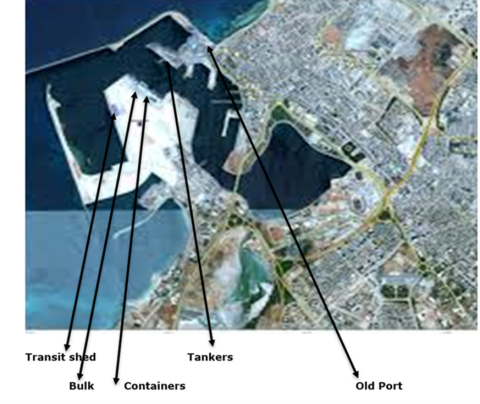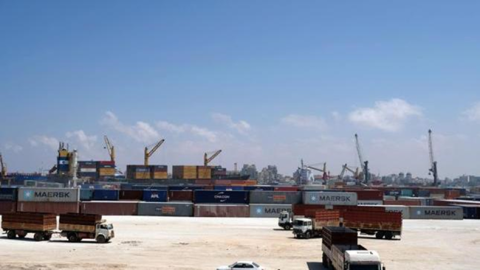Port Overview
The Port of Benghazi is one of the biggest ports in Libya, located in the eastern side of Libya on the Mediterranean coast, with total size: 4,400,000 m². The port is managed by the Libyan Ports Company. The Port of Benghazi resumed operations in October 2017, having suspended operations in 2014, due to internal disruptions. The infrastructure is in workable condition, navigation and buoys are in place. Up until 2007, the Port of Benghazi was the primary gateway for the inward traffic of humanitarian cargo destined to the operations in Sudan and Chad.
The port consists of:
- The old harbour: it contains nine berths (1-9) for receiving general cargo, containers and berthing tugs, the “Old Port “is no longer in use due to infrastructural damage.
- Juliana harbour: It contains nine berths (10-18) for receiving general cargo and containers, silos, direct delivery goods and bulk items.
The port working hours: From Saturday to Thursday, 7:00 to 18:00. The port still runs limited activities outside of the working hours and during holidays, based on the need.
Key port information may be found at: http://www.maritime-database.com
|
Port Location and Contact |
|
|---|---|
|
Country |
Libya |
|
Province or District |
Benghazi |
|
Nearest Town or City with Distance from Port |
Benghazi 8.4 km |
|
Port's Complete Name |
Port of Benghazi |
|
Latitude |
32.112778 |
|
Longitude |
20.040000 |
|
Managing Company or Port Authority |
Libyan Port Company |
|
Management Contact Person |
Hussein Al Sharaa |
|
Nearest Airport and Airlines with Frequent International Arrivals/Departures |
Benghazi Airport Only Libyan airlines depart and arrive from/to the airport |
Port Picture
Description and Contacts of Key Companies
The Port of Benghazi is managed and operated by the Libyan Ports Company.
For more information on port contacts, please see the following link: 4.4 Port and Waterways Companies Contact List
Port Performance
Channel draft is 12.5 m maximum; 11 m vessel depth can access. The port is not currently congested. Humanitarian shipments are given priority at the port. The port has no major limitations/bottlenecks.
The dedicated port shed, located on the quay side, remains structurally sound, repairs are required to the roof, side panels and the sliding doors. The operating structure requires an infusion of cargo handling equipment, warehouse, and terminal space. All the quay walls have new and serviceable fenders which are in good condition. The average waiting time between arrival and berthing is three days.
The “Old Port “is no longer in use due to infrastructural damage.
|
Seasonal Constraints |
||
|---|---|---|
|
Occurs |
Time Frame |
|
|
Rainy Season |
Yes |
From November to March |
|
Major Import Campaigns |
No |
|
|
Handling Figures for 2020 |
|
|---|---|
|
Vessel Calls |
536 |
|
Container Traffic (TEUs) |
59,794 TEU |
|
Handling Figures Bulk and Break Bulk for 2020 |
|
|---|---|
|
Bulk (mt) |
854,678 including container volume |
|
Break bulk (mt) |
898,222 including container volume |
Discharge Rates and Terminal Handling Charges
The port tariffs, as advised by the Port Management, are low compared to the other ports of the region, and government subsidies are in place.
On one hand the lower port rates endeavour to keep the costs of the commodities imported into Libya at an affordable rate, however conversely, there is no mechanism in the rates structure or operating budgets to include a percentage for the purchase of equipment, structured maintenance and the development through training of the human capital. The tariffs are very low, being established back to the 1980s. The below table illustrates open yard container storage tariff in Libyan ports in 2020.
|
Weeks |
Aprox.Total Port tarifs / container |
||
|
20 ft (33.2 m³) |
40 ft (76.3 m³ |
40 ft (88.4 m³) |
|
|
1st |
300 |
600 |
620 |
|
2nd |
320 |
639 |
662 |
|
3rd |
360 |
716 |
749 |
|
4th |
435 |
871 |
922 |
|
5th |
513 |
1,025 |
1,094 |
Berthing Specifications
|
Type of Berth |
Quantity |
Length (m) |
Maximum Draft (m) |
|---|---|---|---|
|
Conventional Berth |
2 |
160 |
6 |
|
Container Berth |
5 |
805 |
8 |
|
Silo Berth |
1 |
170 |
8 |
|
Water Barges |
8.5 |
General Cargo Handling Berths
|
Cargo Type |
Berth Identification |
|---|---|
|
Imports - Bagged Cargo |
898,222 mt |
|
Exports - Bagged Cargo |
NA |
|
Imports and Exports - RoRo |
NA |
|
Other Imports |
854,678 mt bulk |
Port Handling Equipment
The port equipment is managed by the government. The Port of Benghazi is managed and operated by the Libyan Ports Company.
|
Equipment |
Available |
Total Quantity and Capacity Available |
Comments on Current Condition and Actual Usage |
|---|---|---|---|
|
Dockside Crane |
No |
||
|
Container Gantries |
No |
||
|
Mobile Cranes |
Yes |
2 |
Liebherr Mobile cranes (75 mt and 100 mt) |
|
Reachstacker |
Yes |
14 |
45 mt and 12 mt capacity |
|
RoRo Tugmaster (with Trailer) |
Yes |
9 |
45 mt and 60 mt capacity |
|
Grain Elevator with Bagging Machines |
Yes |
11 |
capacity 300 mt per hour and grain ship pneumatic conveyor 120 tons per hour |
|
Transtainer |
No |
The only way to offload containers is by mobile crane |
|
|
Forklifts |
Yes |
19 |
7 mt, 12 mt, and 3 mt |
|
Tugs |
Yes |
5 |
|
|
Mooring Boat |
Yes |
1 |
|
|
Floating cranes |
Yes |
1 |
|
Container Facilities
|
Facilities |
20 ft and 40 ft |
|---|---|
|
Container Facilities Available |
1 yard for 20 ft and 40 ft |
|
Container Freight Station (CFS) |
1 |
|
Refrigerated Container Stations |
Up to 100 stations |
|
Daily Take Off Capacity |
100-150 TEUs |
|
Number of Reefer Stations |
Up to 100 stations |
|
Emergency Take-off Capacity |
150 TEUs |
|
Off take Capacity of Gang Shift |
NA |
Customs Guidance
According to the national legislation, all humanitarian cargos are exempted from duties and taxes. Exemption letter/certificate should be obtained from MOFA and sent to port authority prior to shipment arrival.
Once the custom clearance agent provides all clearance documents and finalizes the normal process, the shipment will be temporarily released, and transported (the shipment would be escorted by custom police) to the organization’s warehouse. Normally it takes from one to three working days to temporarily clear the shipment.
The warehouse will be closed and sealed until the Food and Drug Control Centre tests the commodities and confirms the compliance of the shipment with Libyan standards, thus, issuing the final release.
For more information on customs in Libya, please see the following link: 1.3 Customs Information
Terminal Information
MULTIPURPOSE TERMINAL
Benghazi Port berths’ main activity is receiving general cargo / containers / livestock / oil. Libya’s Ports and Maritime Transport Authority put forward a proposal of the Benghazi marine passenger terminal and yacht marina to local investment.
GRAIN AND BULK HANDLING
The available handling option at the port is to discharge grain and bulk directly to trucks or any mobile tanks to store it outside of the port.
Ship-shore bulk handling equipment are located at berth 7. The most significant traffic is liquid bulk, through tankers. Dry bulk consists mostly of grain and cement.
MAIN STORAGE TERMINAL
|
Storage Type |
Number of Storage Facilities |
Area (m2) |
|---|---|---|
|
Bagged Cargo |
1 |
7500 m² |
|
Refrigerated Cargo |
N/A |
|
|
General Cargo |
1 |
7500 m² |
Stevedoring
The Port of Benghazi is operated by a governmental company, the Libyan Ports Company.
Hinterland Information
All cleared items are moved out of the port by private trucks. The trucks are categorized by size and type, each truck has a sequence number, and all are recorded in a waiting list. The trucks movement process is managed by the Union of Trucks.
Port Security
The port i said to be International Ships and Port Security (ISPS) compliant, presently undergoing an ISPS Audit Level 2.
|
Security |
|
|---|---|
|
ISPS Compliant |
Yes |
|
Current ISPS Level |
2 |
|
Police Boats |
Yes |
|
Fire Engines |
No |




